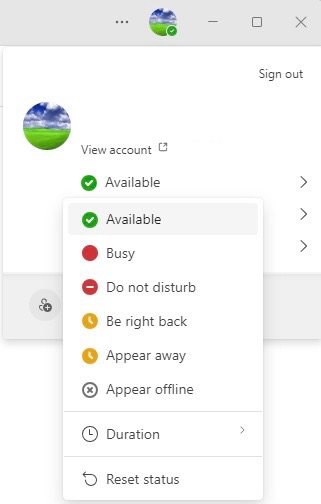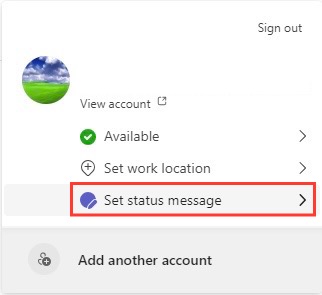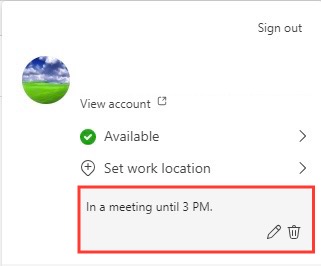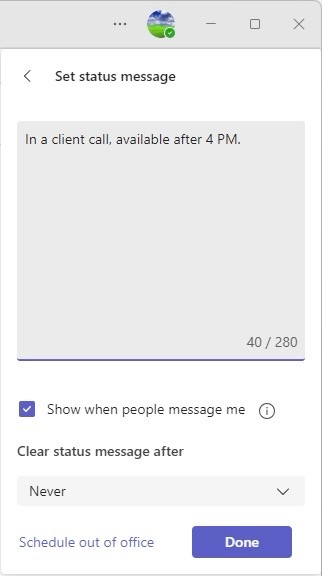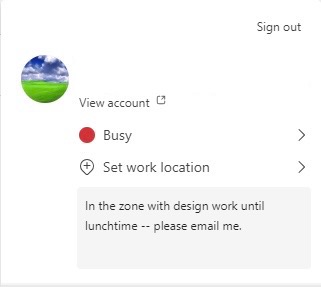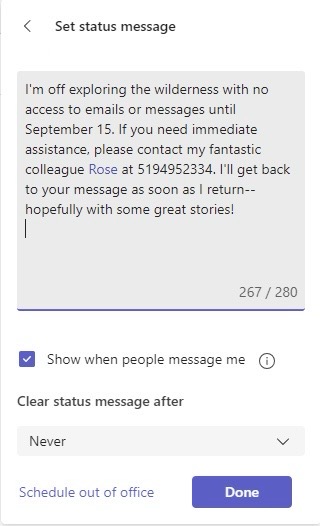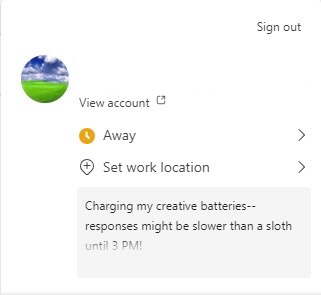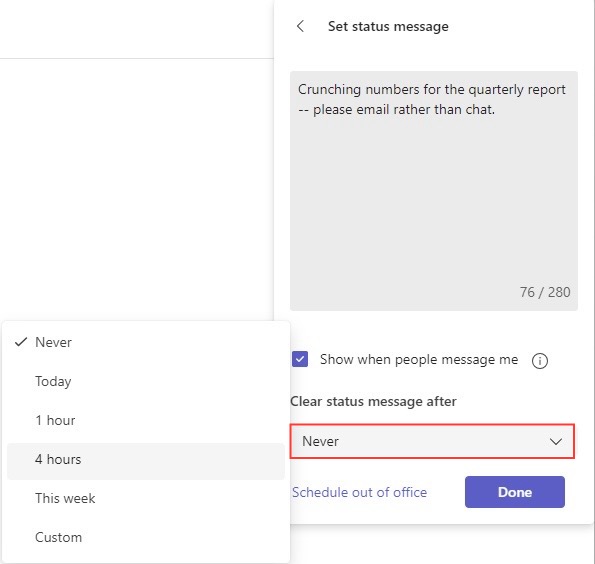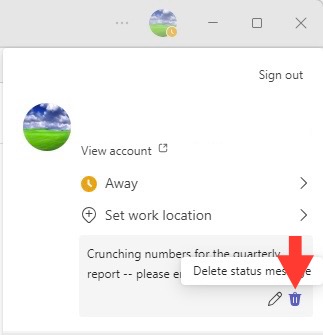Status messages for Microsoft Teams serve as an essential communication tool in a professional environment. They provide colleagues and clients with an instant snapshot of availability or current focus, enhancing the efficiency of the workflow. Just as we view the ‘Open’ or ‘Closed’ sign on a shop door, status messages inform others if we’re virtually ‘in’ and available for a chat or ‘out’ and not to be disturbed.
Key Takeaways
- Personalized status messages in MS Teams can enhance productivity by clearly communicating your availability and situation to colleagues, reducing unnecessary interruptions.
- Effective status messages provide context for your absence, signal when you are seeking focused work time, or indicate delegation of tasks when you are unavailable.
- Incorporating status messages as part of a Microsoft Teams strategy can lead to more efficient team collaboration and ensure smoother workflows within the platform.
Navigating the Basics of Status Messaging in Microsoft Teams
Navigating the basics of status messaging in Microsoft Teams is quite straightforward. Status messages are updates that you can manually set to inform your team or contacts of your availability or activity. By default, Teams will display certain automatic status updates like Available, Busy, or Away based on your activity or calendar, but the real utility comes with custom messages.
When you want to clearly communicate your situation, you can set a custom status message that appears when others view your profile or attempt to message you.
For instance, when I set my status to “In a meeting until 3 PM,” it’s clear to others that I’m not ignoring them but simply engaged elsewhere. Remembering to manage our status messages keeps communication transparent and expectations realistic among team members.
With a status message, we can also give directions or set expectations, such as redirecting queries or notifying when we’ll respond. It’s a polite and efficient way to manage contacts’ interactions without needing to directly address each person during busy periods or absence.
Table of Contents
Crafting the Perfect Microsoft Teams Status Message
The Art of Being Informative and Concise
The art of crafting the perfect Microsoft Teams status message lies in striking a balance between being informative and concise. The goal is to convey your message clearly and quickly, without overburdening your team with unnecessary details. I’ve found that a good rule of thumb is to include just enough information to answer the immediate questions of “Where are they?” or “Can I reach out right now?”
For example, “In a client call, available after 4 PM” succinctly informs others of your current activity and when you might be free, without over-explaining. The beauty of a well-crafted status message is that it respects everyone’s time — both the person setting the status and their colleagues.
When drafting your message, think about what others need to know:
- What is your current availability or activity?
- If you’re busy, when might you be available?
- Is there an alternative contact or resource for immediate needs?
Remember, the key is brevity coupled with complete information. A well-crafted status message removes the need for follow-up questions, reducing interruptions and enabling everyone to work more smoothly.
Situational Examples for Effective Status Messages
In the fluid world of professional communication, situational awareness is key, and your status message should reflect that.
Crafting an effective status message becomes much easier when you consider the context of your workday. Here are a few examples of status messages for various situations:
- Deep Work: “Focusing on project X — no calls, please. I’ll review messages after 2 PM.”
- Meetings: “In team meetings all day. Will respond to messages tomorrow.”
- Creative Process: “In the zone with design work until lunchtime — please email me.”
- Out of Office: “On vacation until [date]. For urgent matters, contact [colleague’s name].”
- Short Breaks: “Stepping away for lunch, back at 1 PM.”
Each message is tailored to a specific situation, informing colleagues of your current activity and when you are likely to respond — maintaining the flow of work without unnecessary disruption.
When I set my status, I always think about who will be reading it. What do they need to know? I aim to pre-empt any questions they might have, which helps eliminate any need for them to interrupt me or to wonder when I’ll get back to them.
Creative Status Message Ideas to Boost Your Microsoft Teams Experience
Out-of-Office Messages that Stand Out
When setting an Out-of-Office (OOO) message in Microsoft Teams, it’s important to leave a memorable impression while also providing necessary details. I want my message to be helpful and possibly even a touch personal, setting a professional yet friendly tone. Here’s an example of an OOO message that stands out:
“I’m off exploring the wilderness with no access to emails or messages until [return date]. If you need immediate assistance, please contact my fantastic colleague [colleague’s name] at [contact info]. I’ll get back to your message as soon as I return—hopefully with some great stories!”
Why it stands out:
- It states the unavailability period clearly.
- It personalizes the message with a touch of humor or personal detail.
- It provides an alternative contact for immediate needs.
- It sets an expectation for when a response will be provided.
- It leaves a positive impression with a forward-looking remark.
Benefits:
- Clearly communicates absence
- Reduces follow-up emails during the absence
- Is memorable and leaves a positive impact
- Encourages contacts to reach out after the return date
- Improves the likelihood of messages getting a response post-return
Cons:
- May be too informal for some professional settings
- Can appear overly personal if not carefully crafted
Best for: Professionals who want to maintain friendly and approachable relations with their contacts, even when they’re not immediately available.
Fun and Engaging Status Updates for Daily Use
Interjecting a bit of fun into daily status updates can enhance team morale and add a touch of personality to the workday. Using fun and engaging status messages not only lightens the mood but also fosters a sense of community among team members. Here’s an example:
“Charging my creative batteries—responses might be slower than a sloth until 3 PM!”
Why it stands out:
- It uses humor to explain a slower response time.
- It’s relatable and humanizing, showing personality.
- The use of imagery (sloth) is memorable and adds levity.
- It sets clear boundaries for availability.
- It indicates I’m engaged in work, though not instantly reachable.
Benefits:
- Breaks the monotony of standard status messages
- Encourages a more relaxed team culture
- Sparks conversations or smiles among colleagues
- Clearly communicates status in a light-hearted way
- Helps in maintaining a positive work environment
Cons:
- Might be perceived as unprofessional in certain corporate cultures
- Could be misunderstood if the humor doesn’t translate well
Best for: Teams with a casual communication style that appreciate a personal touch and the occasional humor interspersed within the workday.
Tips and Tricks for Managing Your Status Messages on Teams
How to Set and Clear a Custom Status Like a Pro
Setting and clearing a custom status in Microsoft Teams like a pro involves just a few easy steps. To set a status, I first click my profile picture, then select “Set status message” from the dropdown menu.
Here I type what I want my contacts to know, like “Crunching numbers for the quarterly report — please email rather than chat.”
In terms of duration, I carefully choose how long the message will be displayed. Finding the right timeframe is crucial—too short, and I might become available without updating my status; too long, and I might forget to clear it when I’m back to being available.
To clear a custom status message, I simply click my profile picture again, choose “Set status message,” and either select the trash icon after my current message or overwrite it with a new one. It’s a little thing, but keeping my status up-to-date ensures smoother interactions and helps me maintain my professional reputation for being responsive and considerate of others’ time.
When to Refresh or Change Your Status for Maximum Impact
Refreshing or changing your status for maximum impact should align with the ebb and flow of your workday. I typically update my status:
- First thing in the morning: To set the tone and availability for the day.
- Before and after meetings: So people know when I’m tied up and when I’m free again.
- When shifting focus: If I move from collaborative work to deep focus, for example, I adjust my status to manage expectations.
- After significant changes in my schedule: If an appointment gets canceled or a project deadline changes, I immediately update my status.
- Before signing off for the day: To let my colleagues know that I am no longer available.
Regular updates keep communication transparent. I’ve noticed they reduce unnecessary interruptions and help everyone plan their collaboration efforts more effectively.
Leveraging Status Messages for Improved Team Dynamics
Enhancing Visibility and Accessibility with the Right Status
Enhancing visibility and accessibility starts with using the right status to signal my presence and availability. A well-chosen status ensures that my colleagues know when I am instantly reachable, when I’m available but not immediately so, and when I’m away from my desk.
For instance, if I am working on a time-sensitive task, I set my status to “Do Not Disturb” to maintain focus. But if I’m available for quick questions, I might use “Available” but clarify in a custom message: “Free for a chat, but heads-down on reporting.”
An effective status not only informs my team of my current status but also guides them on how to proceed—whether to wait, contact someone else, or send an email instead.
Using Status Messages as a Tool for Remote Work Efficiency
As a remote worker, I find that status messages are an indispensable tool for efficiency. They bridge the gap created by physical distance and clarify my work rhythms to my team. For example, indicating “Remote: Focused task – reachable by urgent Slack only” lets my colleagues know I’m not in the office and that even though I’m engrossed in work, I am accessible for pressing matters.
Such status messages alleviate the ambiguity of remote work scenarios. They demonstrate that, despite the absence of shared physical space, we can maintain a cohesive and responsive team dynamic. Thoughtfully updating my status as my workday progresses ensures that my remote collaboration is as efficient and unambiguous as being in an office setting.
FAQ: All You Need to Know About Microsoft Teams Status Messages
What is the Purpose of a Status Message in Microsoft Teams?
The purpose of a status message in Microsoft Teams is to communicate my current availability and activity to colleagues. It lets them know when I’m free to chat, when I’m busy in a meeting or focused on work, or when I’m out of the office. This improves collaboration by setting clear expectations for when I can be reached or when I’ll respond to messages.
Can I Schedule Status Messages in Advance on Teams?
Yes, I can schedule status messages in advance on Microsoft Teams. This feature is particularly handy when planning for meetings, days off, or extended focus sessions. It lets me manage my availability and ensures that my team knows when I will be unavailable ahead of time.
How Do I Ensure My Status Message Is Seen by Others?
To ensure my status message is seen by others in Microsoft Teams, I select the option “Show when people message me.” This displays my message whenever someone tries to contact me, making it highly visible. Consistency and clarity in the status message also help others to notice and respect my availability.
What Are Some Creative Status Message Examples for Microsoft Teams Users?
Some creative status message examples for Microsoft Teams users include:
- “On a creativity quest — back once I’ve caught the muse!”
- “Brewing ideas like a fresh pot of coffee. DM for a cuppa chat after 3 PM.”
- “Riding the productivity wave 🏄 Please hold calls till I’m back on the beach at 5 PM.”
- “On a digital detox, responding only to carrier pigeons until 12 PM.”
- “Juggling tasks! 🤹 Available for a chat once everything is up in the air.”
These messages give my status a personal touch and can bring a smile to my colleagues’ faces, while clearly communicating when and how I’m available.
John Michaloudis is a former accountant and finance analyst at General Electric, a Microsoft MVP since 2020, an Amazon #1 bestselling author of 4 Microsoft Excel books and teacher of Microsoft Excel & Office over at his flagship MyExcelOnline Academy Online Course.

